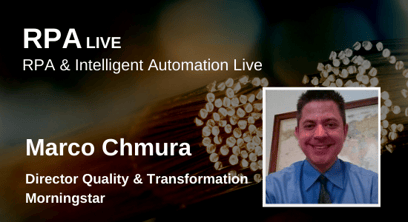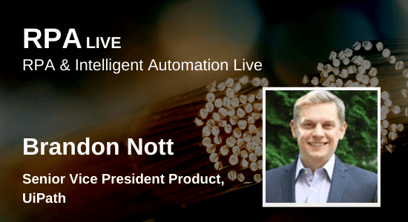Creating A World of Virtual Health Care and Health Sciences Using A.I., ML and RPA
Donald will describe in detail how he created and delivered the world's first national virtual practice of medicine, and hands-free pharmaceutical manufacturing management using:
1) Artificial Intelligence and Deep Machine Learning
2) Radio Frequency Technology and Robotic Process Automation
3) Machine Vision and Speech Synthesis
4) Digitization and Virtualization
5) Encryption for Medical Records management HIPAA Compliance
6) Hand Held Device Enablement for visualizing global multiple site pharma
manufacturing, and patient office visit and procedure scheduling
7) Zero Defect Physician Licensing and Credentialing in all 50 States and
Puerto Rico
Click Here To View The Full Session Transcript And Recorded On-Demand Session Video
RPA For the Enterprise
Welcome to the world of the new robo worker. With an ever-expanding need to automate business and technical processes, the scope and scale of other solutions are being challenged. As reliance on automation grows, it becomes increasingly important to choose an enterprise-grade, always-on solution that scales. Businesses need a robotic automation solution designed to support a highly-available, scalable, secure and resilient platform, yet still provide an intuitive design experience enabling low- or no-code authoring.
In this session, we will:
-
- Demonstrate how to build an RPA process with no coding required
- Show how to build an RPA process that uses both API and UI actions
- Talk about why UI automation is difficult for some vendors
- Discuss a critical, real-world customer financial challenge, focused on reducing human resources to perform a time-sensitive and daily need
- Share the savings and benefits of implementing RPA from actual customer examples
Click Here To View The Full Session Transcript And Recorded On-Demand Session Video
Hyper-automation powered by process excellence – Best practices by LexisNexis
Many enterprises are pursuing automation initiatives across BPM, RPA and AI. The underlying strategic goal behind these automation projects is Digital transformation that will help deliver operational efficiencies and competitive advantages for the firm. Unfortunately, most enterprises don’t realize that silo automation efforts can create technology debt or short lived efficiencies when they don’t address the underlying processes and prepare the process for digital target state before applying technologies.
The concept of hyper-automation highlights the value of holistic automation across tasks, processes, data, content, collaboration and conversations with a repeatable approach to managing automation projects from idea to delivery.
This presentation will address key concepts, methodology and best practices involved in establishing enterprise automation programs built on the foundation of process excellence.
Click Here To View The Full Session Transcript And Recorded On-Demand Session Video
Cutting Through the Noise - How can you use AI Solutions to Drive Excellence now?
- Overview and evolution of Intelligent Automation Capabilities (AI, Machine Learning, Natural Language Processing, OCR, RPA)
- Discussion about emerging mainstream use cases and areas of early adoption
- Pivot discussion towards real-world challenges
- Fact vs. Fiction limitations of AI today
- Culture and Change Management
- Concept of defensibility/interpretation of model to be expanded upon- “can’t blindly trust the black box”
- Update on regulatory concerns
- Models for success
Click Here To View The Full Session Transcript And Recorded On-Demand Session Video
From Pilot to Enterprise-scale RPA: How to Amplify and Accelerate the Business Value of RPA to Build a Thriving Enterprise
As companies adopt an ‘automation first’ mindset and the demand for enterprise-wide automation continues to grow, business and technology leaders grapple with how to most effectively—and efficiently—plan and organize automation approaches and deployments and scale across the enterprise.
The good news for the enterprise is that wherever you are on your automation journey, there are footprints to follow to help leaders chart the best path from initial RPA pilot implementations to large scale, enterprise-wide deployments.
In this session, Blueprint CTO Tony Higgins will share how to rapidly and effectively scale RPA enterprise-wide to unleash the full value that process automation brings, create significant bottom-line impact, and design your business for long-term resiliency, including how to:
- Prioritize and expand your RPA to broader, more complex, end-to-end business processes
- Enable business users and developers across your organization to collaborate and manage automations from concept, to development, to implementation and maintenance
- Accelerate RPA development
- Reduce RPA maintenance costs by ensuring you build the right automation the right way the first time
- Determine and manage the impact of technology or business-level changes on RPA deployments
- Ensure the right governance for automation at scale
Click Here To View The Full Session Transcript And Recorded On-Demand Session Video
Proprietary AI algorithm driven “Zero Touch” fault resolution for mobile network alarms
RPA teams are often challenged by the limitation of the existing RPA toolset, in being unable to automate knowledge based tasks. Many RPA products have incorporated the magic terms “AI” or “Analytics”, however on closer examination, one quickly finds that most solutions are either too narrow or there is misrepresentation of AI/ML capabilities.
In 2017, our RPA CoE at Nokia, set out to create a general solution for Nokia RPA 2.0, which would integrate Nokia’s AI/Analytics platform (used as “Brains”) & RPA technology (used as “Hands”) and bring in the capability of automating judgement driven complex processes. We selected this use-case as our pilot as it had the required cognitive complexity to necessitate use of deep-learning algorithms, sufficient volumes to produce a viable business case & was scalable across multiple customers.
This session will summarize this story of conceptualizing, implementing, improving and achieving success, including lessons learnt during this journey.
Key Takeaways
- How to visualize and set-up a general solution for RPA augmented with AI/ML algorithms
- Business case set-up & managing organization’s expectations/response – what is unique for such systems
- Nuances and operational challenges of implementing such systems
- Outlook for such systems
Click Here To View The Full Session Transcript And Recorded On-Demand Session Video
Does Robotic Process Automation Take Jobs Away?
A common myth about Robotic Process Automation (RPA), fueled by a fear of losing livelihoods, is that RPA will replace all jobs. Is RPA really taking over, or is it liberating human intelligence from mundane, repetitive, error-prone tasks so you can invest in more creative, innovative, and productive initiatives?
- What can RPA really do for you?
- How are organizations using RPA right now?
- Can RPA really help to reduce IT costs?
- How can you build an RPA process that uses both API and UI actions?
Click Here To View The Full Session Transcript And Recorded On-Demand Session Video
Cloud Computing for Data Analytics Applications
Data Analytics is the foundation of modern decision-making process It allows analyzing raw data tomake important decisions. During the recent Covid-19 virus epidemic we saw the power of analytics topredict the severity and the duration of the epidemic.
In every decision made by hospitals, medical professionals, and government used analytics to plan the response to this disease. For every busines sexecutive it is essential to understand basic principles of analytics. First, this seminar offers basic information about analytics which includes machine learning and deep learning. Next it enumerates the tools necessary for building analytics models. Analytics models are currently built using TensorFlow/Keras, Python/R software products and require asignificant amount of computing resources.
This precludes running analytics models on personal computers. Generally, they are not powerful enough. Analytics models usually run on cloud servers because they have enough computing resources. Consequently, Fortune 500 companies build analytics models on cloud servers. Cloud servers provide access to GPU (Graphics Processing Units) and TPU (Tensor Processing Units).
These processors can execute trillions of floating instructions per second. Due to parallel processor architecture built in GPU and TPU, they are ideal for matrix multiplication operations—the most frequently used operation in analytics models. The 3 most popular cloud services are AWS (Amazon Web Services), GCP (Google Cloud Platform), and Azure from Microsoft. Cloud servers provide general computing service in three “flavors” –Infrastructure, Platform, and Software.
They also provide the services uniquely necessary for analyticsprojects. This seminar will examine these cloud services in detail. A comparison of them will be explored from theperspective of which cloud service is better suited for analytics models. Next, the seminar will focus onhow to set up cloud servers for analytics projects.
Click Here To View The Full Session Transcript And Recorded On-Demand Session Video
The Transformation to Intelligent Enterprise
You are standing in a room amidst a sea of different unsolved jigsaw puzzle and a pile of loose pieces yet to be connected. Each puzzle must be solved simultaneously while new puzzle pieces are streaming into the room from all angles.
There is no obvious indication of which piece goes with which puzzle, and you only have fractions of a second to decide where a piece may fit into every puzzle in the room and some pieces may fit into multiple puzzles. The time you have to make sense of all this, your window of opportunity, is the time it takes the customer to click a choice in a Digital property, move their eyeball to a new location of a Physical property, or the milliseconds that define a span of time for the next best action.
Now let’s think about puzzles in another different domain, security, are you safe? Who is a potential insider threat? How do you know? These are just different puzzles to solve, the unknowns are the puzzles. How do you answer the unknown and deliver insight that is thought to be impossible? How do you do this with precision and better than your competitors? We will introduce the basics in this discussion.
Takeaways include:
- Success requires an Ecosystem of partners.
- No substitute for talent – You get what you pay for.
- Cloud is a necessity and the Security model must change and become a strategic advantage.
- Transformation requires that data and analytics be a priority.
- Lack of sufficient IP portfolio makes you susceptible to legal challenges.
Click Here To View The Full Session Transcript And Recorded On-Demand Session Video
Control your robots – Designing an effective RPA governance program
It’s easy to underestimate the work and time involved in satisfying the needs for RPA governance, whether your business complies with SOX or not. Marco Chmura, Director of Quality & Transformation at Morningstar will share their journey in building effective controls as they’ve continued to expand their program (now in year 3) to key processes interacting with SOX sensitive applications.
Some highlights:
-
What does success look like and what’s needed to achieve it?
-
Partnering early on with Compliance & IT/Security teams on:
-
Security Administration needs
-
Establishing Change Management & Appropriate segregation of duties
-
Fulfilling Backup and Recovery requirements
-
Identifying and empowering a core process review team
-
Controls in place, SOX sign-off received – What’s next for RPA program?
Click Here To View The Full Session Transcript And Recorded On-Demand Session Video
A Robot for Every Person
The UiPath vision is a robot for every person. And we’re building our product to help that vision become a reality.
-
Look inside StudioX and how it helps citizen developers and power users create their own robots.
-
See how Automation Hub enables teams to share robots and submit automation ideas.
-
Learn how the concept of a robot for every person is helping organizations today.
Click Here To View The Full Session Transcript And Recorded On-Demand Session Video
Lessons Learned from successful RPA Implementations that have saved millions of dollars
RPAs can be used to ease the connection and interface between different technologies or between old legacy and newer systems. It is perfect to replace processes that are highly manual, rule-based, and repetitive. While this tool has proven success, they come with a big bill and lots of monitoring and validation.
While RPAs can save significant cost and time they cannot replace fully integrated systems that talk to each other without the need for a middle-channel to bend the data and translate into other forms. I will provide several examples of how we utilized RPAs to save millions of dollars and avoid significant headache. I will also list some steps I would do differently next time I implement an RPA project.
- RPAs are fantastic, if they are done right and if the right resources/partners have been utilized
- Significant cost and time can be saved using RPAs
- Monitoring and validation can come with big bills
- Next time I implement RPAs I would probably invest in resources
- Many RPAs can last for years and can do magic
- When translating data between different systems/technologies, RPAs are great “band-aids” that can temporary replace fully integrated systems. However, a fully integrated system should be the ultimate goal if money, resources, and time are available because the solution is native and should works seamlessly.
Click Here To View The Full Session Transcript And Recorded On-Demand Session Video

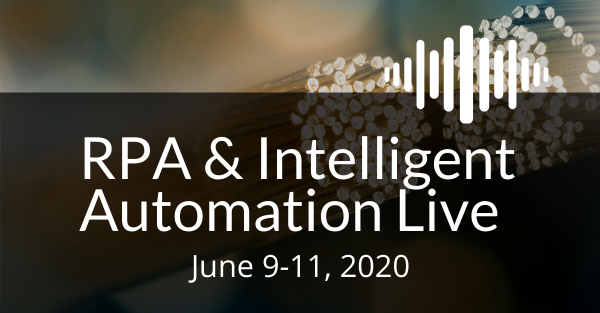

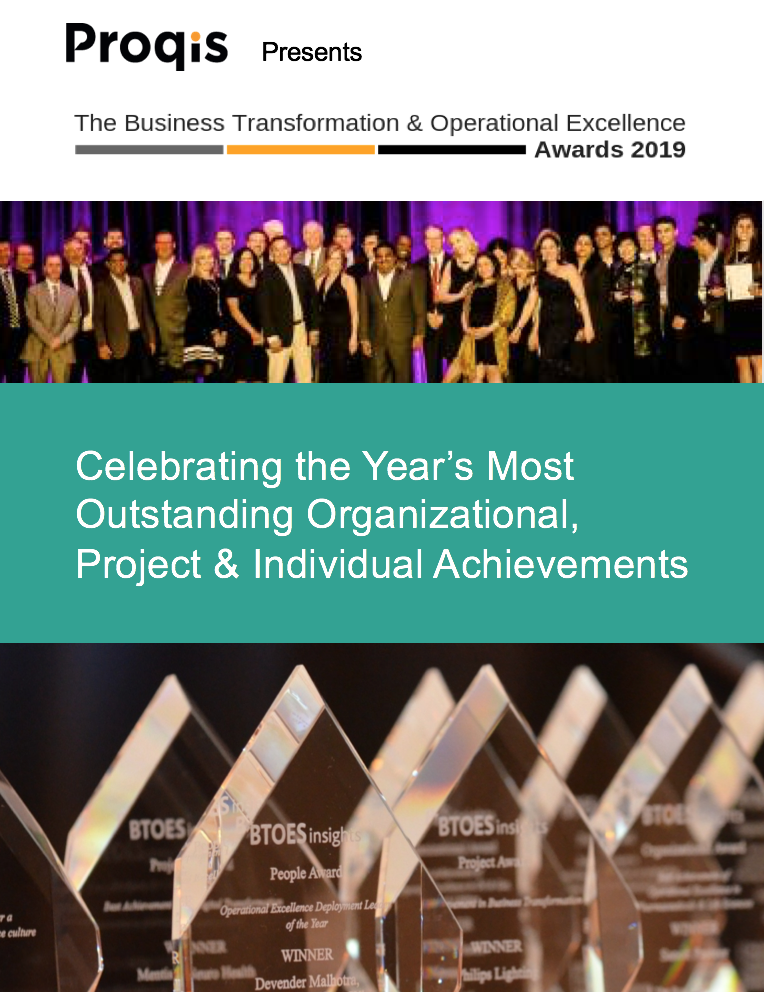
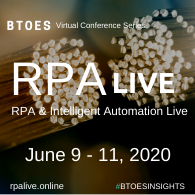
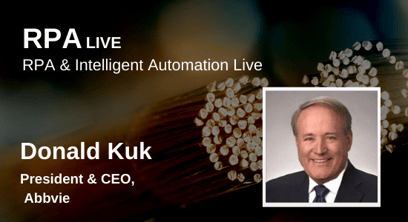
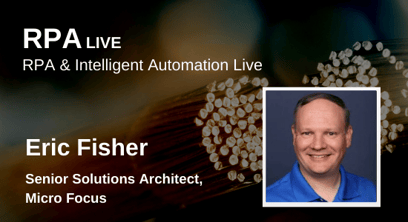
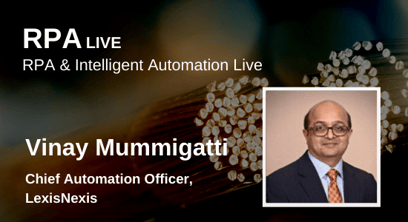
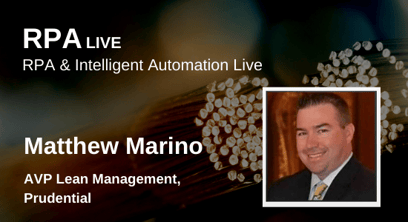
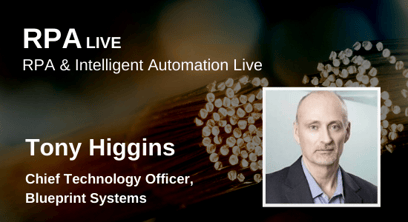
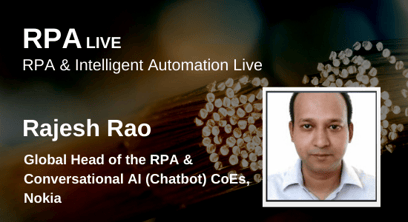
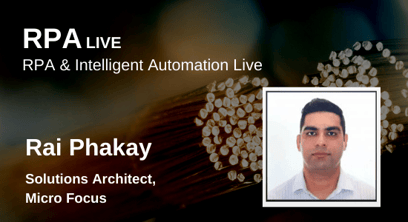

-1.png?width=408&name=OnDemand%20Speakers%20(2)-1.png)
